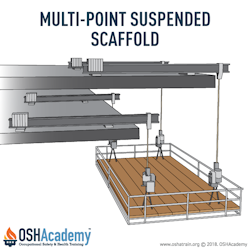Inspecting Multiple-Point Adjustable Scaffolds
A multiple-point adjustable suspension scaffold is a suspension scaffold consisting of a platform(s) suspended by more than two ropes from overhead supports and equipped with means to permit the raising and lowering of the platform to desired work levels.
- A stone setter's multiple-point adjustable suspension scaffold is a two-point or multiple-point adjustable suspension scaffold designed and used for stone setting operations.
- A mason's adjustable suspension scaffold is a two-point or multiple-point adjustable suspension scaffold designed and used for masonry operations.
When inspecting multi-point adjustable scaffolds, check for each of the following:
- Make sure multi-point adjustable scaffolds are suspended only from:
- metal outriggers
- brackets
- wire rope slings
- hooks
- means that meet equivalent criteria for strength, durability, etc.
- When two or more scaffolds are used they are not bridged together unless:
- their design allows them to be connected
- the bridge connections are articulated
- the hoists are properly sized
- If bridges are not used, make sure the passage between platforms is made only when they are at the same height and are abutting.
When inspecting a mason’s multi-point adjustable suspension scaffold, check each of the following:
- Make sure that for a maximum intended load of 50 pounds per square foot, each outrigger beam is at least a standard 7 inch, 15 foot, 15.3 pound steel I-beam.
- Make sure outrigger beams do not project more than 6 feet 6 inches beyond the bearing point.
- Make sure overhangs exceeding 6 feet 6 inches are composed of stronger outrigger beams or multiple beams.
Knowledge Check Choose the best answer for the question.
6-4. Multi-point adjustable scaffolds are typically _____.
You forgot to answer the question!

